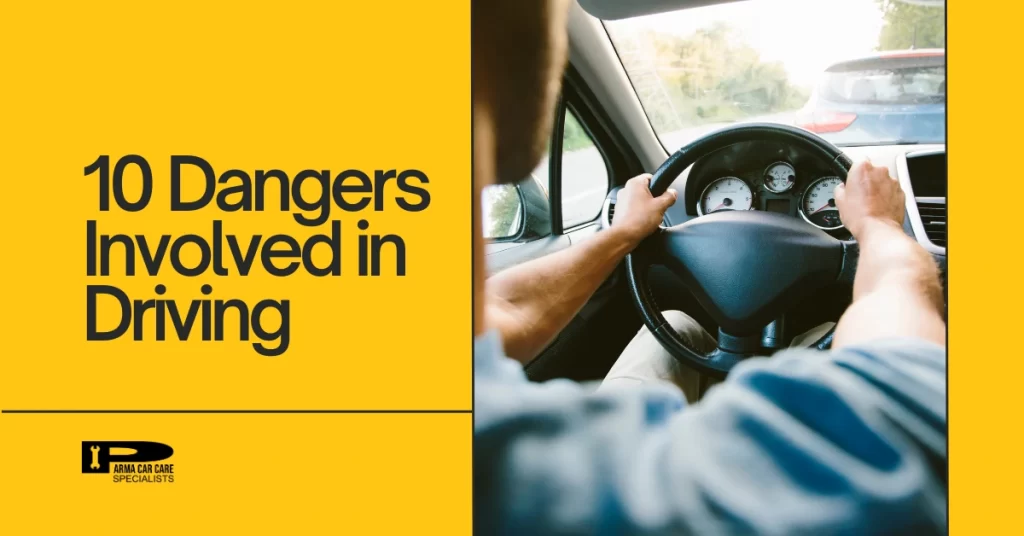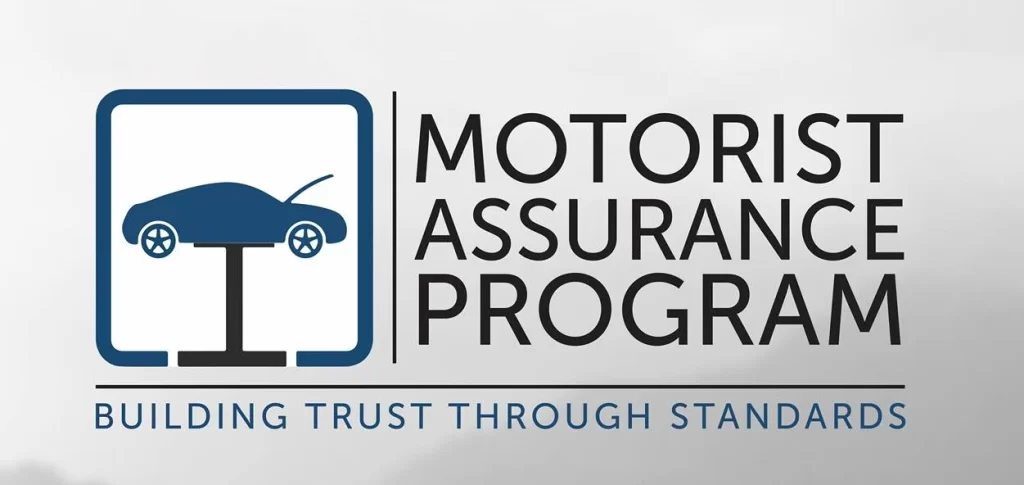Driving can be quite perilous, mainly due to ten common hazards. You may encounter heavy traffic or unpredictable weather conditions such as icy roads and water puddles, complicating your drive. Road conditions like invisible oil slicks or sudden blind curves add to the challenges. Traffic-related issues like malfunctioning traffic lights or construction work zones often lead to confusion and increased risk. Behavior of others on the road, including reckless drivers or animals crossing automatically escalates the dangers. While it’s intimidating, each risk can be mitigated with awareness, preparedness, and appropriate response strategies that you’ll learn about as you proceed.

Key Takeaways
- Environmental hazards such as heavy traffic, icy roads, water puddles, oil slicks, and potholes increase the risk of accidents.
- Traffic control and visibility issues like faulty traffic lights, blind curves, and construction zones can cause confusion and collisions.
- Heavy machinery, especially during construction work, can obstruct visibility and lead to serious accidents.
- Reckless driving, including drunk driving and deliberate disregard for traffic rules, can endanger all road users.
- Unexpected animal crossings, particularly in rural areas, pose a significant danger to drivers.
Heavy Traffic
Maneuvering through heavy traffic isn’t just frustrating, it’s also potentially dangerous. You’re surrounded by drivers of varying skill levels, all attempting to reach their respective destinations in the quickest time possible. The complexity increases when rain enters the equation. The dangers of driving in the rain within heavy traffic are manifold and they demand your attention.
Rain reduces visibility, making it harder for you to see other vehicles. It also decreases your car’s grip on the road, increasing the likelihood of skidding. Couple this with the congested traffic, and the slightest miscalculation or delayed reaction can result in an accident. It’s essential to maintain a safe distance from the car in front, as braking distances increase on wet roads.
Moreover, heavy rain can lead to what’s known as hydroplaning. This is when a layer of water builds up between your tires and the road, causing you to lose control of your vehicle. It’s unpredictable and can occur even at low speeds.
In heavy traffic, the risk of hydroplaning increases exponentially, making this a significant hazard. Your safety in these conditions relies heavily on your awareness and cautious driving.
Icy Roads
Maneuvering icy roads can be an unnerving experience, even for the most seasoned of drivers. The dangers of driving increase substantially when the pavement is slick with ice. It’s not just the fear of skidding or spinning out that’s concerning; it’s the unpredictability of it all.
You can’t see black ice; it blends with the road. One moment you’re driving along just fine, the next, you’re sliding out of control. It’s a heart-stopping, breath-taking moment that can lead to severe accidents, injuries, or worse.
Strategies like reducing speed, avoiding sudden braking, and keeping a safe following distance from the car ahead can mitigate these risks. But, they’re not foolproof. Even with the best of precautions, you’re still vulnerable.
And if you hit a patch of ice and start to skid, do you know how to steer into it? It’s counterintuitive and goes against your natural instincts. But it’s often the best chance you have to regain control.
The dangers of driving on icy roads are real and tangible. Your best defense is awareness, preparation, and constant vigilance. Drive safe.
Water Puddles
Just as icy conditions pose a significant threat to drivers, so too can the seemingly innocuous water puddles. They’re not just minor road nuisances; they can pose serious dangers, particularly when you’re distracted.
The dangers of distracted driving increase exponentially when water puddles come into play. You see, puddles can hide potholes or road debris, potentially causing tire damage or even loss of vehicle control if you hit them unexpectedly. That’s why it’s critical to keep your eyes on the road and avoid distractions.
Deep water puddles also present a risk of hydroplaning. This occurs when a layer of water separates your tires from the road surface, leading to a loss of traction.
You lose steering control, which can lead to accidents, especially at high speeds. It’s a scary prospect, isn’t it?
Oil Slicks
Oil slicks pose another serious hazard to drivers. You mightn’t always see them, but they’re there, lurking on the road surface, ready to disrupt your vehicle’s grip. The dangers of distracted driving compound this risk, making it even more essential to stay alert.
- Visibility: Oil slicks can be nearly invisible, especially after a light shower. If you’re not paying attention, you might drive right into one, causing your tires to lose traction.
- Control: Once you’re on an oil slick, it’s hard to maintain control of your vehicle. Even the slightest steering adjustment can cause a skid. Distracted driving worsens this, as your reaction times are slower.
- Recovery: Recovering from an oil slick skid requires quick thinking and precise movements. Don’t slam on the brakes; instead, ease off the gas and steer gently in the direction you want to go.
Understanding these risks intensifies the importance of remaining vigilant behind the wheel. The dangers of distracted driving aren’t just about texting or talking on the phone, but also about being aware of road conditions like oil slicks.
Stay alert, stay safe.
Faulty Traffic Lights
Maneuvering through intersections with faulty traffic lights can pose a significant challenge and risk to drivers. You’re suddenly thrust into a situation where normal rules don’t apply, and split-second decisions are necessary. It’s a situation that calls for utmost attention.
Yet, it’s in these vital moments that the dangers of distracted driving become most glaring. If you’re not fully focused, you might miss the fact that the traffic light isn’t working. You may continue driving at the same speed, only to collide with another vehicle that also didn’t notice the fault. The repercussions can be severe, including severe injuries or even fatalities. Hence, the importance of undivided attention while driving can’t be overstated.
Moreover, faulty traffic lights also lead to confusion and impromptu decisions, which often result in accidents. You may assume other drivers will stop, but if they’re also unsure or distracted, collisions are inevitable.
To mitigate this, it’s essential to approach intersections cautiously, especially when you notice erratic behavior from other drivers.
Potholes
Ever hit a pothole in the middle of the road? It’s not just annoying; it can be dangerous, especially if you’re not paying attention. The dangers of distracted driving are amplified when unexpected obstacles like potholes come into play.
- Damage to Your Vehicle: Hitting a pothole can result in tire blowouts or damaged suspension.
Even if you don’t notice immediate effects, the impact could lead to long-term wear and tear.
- Loss of Control: A sudden jolt could cause you to lose control of your vehicle, especially if you’re driving at a high speed or are momentarily distracted.
This can result in accidents, sometimes severe.
- Risk to Other Road Users: Swerving to avoid a pothole can be just as dangerous as hitting one.
You risk colliding with other vehicles, pedestrians, or roadside infrastructure.
Blind Curves
Maneuvering blind curves can be one of the most nerve-wracking experiences on the road. The apprehension escalates when you’re unaware of what’s around the bend. It’s a situation where the dangers of distracted driving become glaringly apparent.
Blind curves, by their very nature, limit your field of vision. As a result, your ability to react to unexpected obstacles or changes in the road is greatly reduced. Whether it’s oncoming traffic, a pedestrian, or an animal, the surprises can be many, and your response time is minimal.
When you’re approaching a blind curve, it’s absolutely essential to minimize distractions. This isn’t the time to be changing the radio station, looking at a map, or texting. Your focus needs to be on the road and your hands firmly on the wheel.
It’s a time when your full attention and quick reflexes can mean the difference between a close call and a catastrophic accident.
Construction Work Zones
While blind curves demand your undivided attention, construction work zones present their own unique set of hazards on the road. These zones often introduce abrupt changes in driving conditions that can be disorienting, especially if you’re not paying full attention.
- Unpredictable Elements: Construction zones can be riddled with sudden lane shifts, uneven surfaces, and temporary signs. This unpredictability necessitates a higher level of vigilance, and the dangers of distracted driving become considerably amplified.
- Heavy Machinery: You’ll often encounter large construction vehicles that can block your view. Remember, if you can’t see their mirrors, they can’t see you.
- Workers on the Road: Workers can be present just feet away from moving traffic. Their safety rests in your hands.
To navigate these zones safely, slow down, stay alert, and follow the posted signage. Distractions, like using a cell phone, can lead to dire consequences.
Understanding the potential dangers helps in developing a defensive driving strategy, thereby reducing the risk of accidents. You’re not just protecting yourself; you’re also safeguarding the lives of construction workers and other drivers sharing the road.
Reckless Drivers
In the chaotic landscape of the road, reckless drivers pose one of the greatest threats to safety. You may think you’re in control, but one wrong move by a careless driver can change everything. Recklessness isn’t merely a lack of attention; it’s a deliberate disregard for the rules of the road and the safety of others.
Now, let’s explore the dangers of drunk driving, a prime example of reckless behavior. Alcohol impairs judgement, coordination, and reaction times, transforming a vehicle into a potential weapon.
Inebriated drivers are a ticking time bomb, their impaired state making them incapable of making safe and rational decisions. What’s worse, they often overestimate their ability to drive, leading to high-speed collisions, fatal injuries, and devastating losses.
It’s not only the drunk drivers who suffer; innocent bystanders and other drivers bear the brunt of their recklessness.
Animals Crossing Roads
Shifting gears from the hazards posed by reckless drivers, there’s another peril that often goes unnoticed until it’s too late – animals crossing roads. You might think it’s a rare occurrence but it’s more common than you’d imagine, particularly in rural and suburban areas where wildlife is abundant. The dangers of distracted driving compound this risk considerably.
Here are three essential points you should consider:
- Be Alert: You can’t predict when an animal might cross your path. Always stay vigilant, especially in areas marked with wildlife crossing signs.
- Use Your High Beams: Except when there’s oncoming traffic, use your high beams at night. They can help spot animals from a distance.
- Don’t Swerve: If an animal appears suddenly, brake firmly but don’t swerve. It could lead to a more dangerous situation.
Understanding these risks and knowing how to react could save not only your life but also the lives of the animals.
The key is to remain focused and not let anything – whether it’s a text message, a fascinating podcast, or even the beauty of the landscape – distract you from the road.
Frequently Asked Questions
What Are the Risks Associated With Driving on Underinflated or Worn-Out Tires?
Driving on underinflated or worn-out tires can increase your risk of tire blowouts, poor handling, and decreased fuel efficiency. It’s essential to regularly check tire pressure and replace worn tires to guarantee safe driving conditions.
How Can Poor Vehicle Maintenance Contribute to Road Accidents?
Poor vehicle maintenance can lead to unexpected breakdowns, reducing your control over the car. It’s critical you regularly service your vehicle to avoid malfunctions that can result in serious road accidents.
What Dangers Do Distracted Driving, Like Texting or Eating, Pose on the Road?
When you’re distracted by activities like texting or eating, you’re not fully focused on driving. This increases your chances of accidents, as you might not react in time to unexpected events or changes on the road.
Why Is It Dangerous to Drive With a Malfunctioning Brake System?
Driving with a faulty brake system’s dangerous because it compromises your ability to stop or slow down in time, potentially causing collisions. Regular inspections and maintenance are essential to guarantee your brakes are functioning properly.
How Do Adverse Weather Conditions Like Fog or Heavy Rain Impact Driving Safety?
Adverse weather conditions like fog or heavy rain greatly impair your visibility. They can make roads slippery, increasing your risk of accidents. It’s essential to drive slowly, use your headlights, and maintain a safe distance.
Conclusion
Driving demands diligence. Deciphering dangers, from crowded commutes to icy intersections, is essential. Water puddles, oil slicks, and faulty traffic lights further fuel the risks. Blind bends, bustling construction zones, and brash drivers increase the intricacy. Even unexpected encounters with crossing creatures come with complications. Consequently, car care counts. Recognizing these risks requires your responsibility, not just for your safety, but for sharing safer streets. So, stay sharp, stay safe, and steer clear of these potential perils.
















